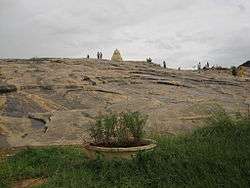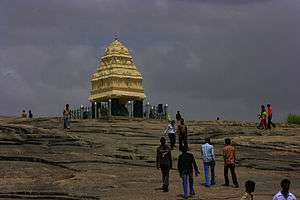Peninsular Gneiss
| Peninsular Gneiss Peninsular Gneiss Geological Monument at Lalbagh | |
|---|---|
| neighborhood | |
 | |
 Peninsular Gneiss Location in Bengaluru, India | |
| Coordinates: 12°56′46″N 77°35′10″E / 12.946°N 77.586°ECoordinates: 12°56′46″N 77°35′10″E / 12.946°N 77.586°E | |
| Country |
|
| State | Karnataka |
| District | Bangalore Urban |
| Metro | Bengaluru |
| Languages | |
| • Official | Kannada |
| Time zone | IST (UTC+5:30) |
Peninsular Gneiss is a term coined to highlight the older gneissic complex of the metamorphics found all over the Indian Peninsula. This term was first fashioned by W.F.Smeeth of the Mysore Geological Department in 1916 based on the first scientific study of this rock exposure. The Geological Survey of India identified one of the best exposures of this rock mass, protruding high above the ground as a hillock (pictured), dated 2.5 to 3.4 billion years, in the Bangalore city in India at the famous Lalbagh gardens and declared it as a National Geological Monument to propagate the knowledge of the rock formation among the public, since Lalbagh is frequented by visitors from all over the world.[1][2] It is also called the Lalbagh rock.[3]
As general information, gneiss is a coarse-grained high grade metamorphic rock formed at high pressures and temperatures in which light and dark mineral constituents are segregated into visible bands.[1]
Geology


The Archean gneisses and schists, which are the oldest rocks of the Indian Shield, constitute a considerable area of Peninsular India. The Dharwar (Super Group) and the Peninsular Gneissic Complex are the classified groups of the Precambrian rocks of India. The extent of the Archean system is depicted as the dominant system of South India in the pictured Geological Map of India.
In most stratigraphic schemes, the peninsular gneisses are shown as the younger Archaean strata situated above the Sargur Group. Granitization of the older sedimentary–volcogenic sequence are reported as sources of the peninsular gneisses made up of polyphase migmatites, gneisses and granites ranging in composition from granodiorite to tonalite.[4]
The rocks of the Dharwar Group, which are mainly sedimentary in origin, occur in narrow elongated synclines resting on the gneisses found in Bellary district, Mysore and the Aravallis of Rajputana.
The supracrustal rocks of the Dharwar Group of the southern Indian Peninsula, as depicted in the geological map of South India, have the Peninsular Gneiss as the basement rock formation, also stated to be the remobilized basement. Migmatization of pre-existing metasedimentary and meta–igneous rocks are considered the contributors to formation of the composite gneiss.[2][5]
Geology of the Lalbagh hill monument
The Lalbagh hill, which has been declared as a Geological Monument (plaque pictured) to represent the Peninsular Gneiss, has dark biolite gneiss of granitic to granodioritic composition containing streaks of biolite. Remnants of older rocks are seen in the form of enclaves.[1] The research information of the geological record of the gneisses, collated and reported in the publication “Geological Monuments of India” published by the Geological Survey of India, is quoted below to provide an undiluted version.[2]
A common enclave is a dark grey to black rock called amphibolite containing the minerals plagioclase feldspar and hornblende. Due to interactions with granite fluids, these enclaves have developed a border rich in biotite mica. Later magmatic activity represented by grey poryphiritic granite followed by pink massive granite is also seen at several places. The gneisses and granites have been profusely invaded by still younger veins of coarse grained pegmatite which have cut up the gneisses into several irregular and lenticular shapes.
.
The earliest rock was a dark coloured amphibolite which was converted into grey biotite gneiss during migmatization. The grey biotite gneiss during migmatization was first intruded by grey porphyritic granite and later by pink granites. Pegamatities of several generations have traversed all these rocks.
Geological age
Initial studies on the Gneiss samples of the Lalbagh hill and other locations in Bangalore, carried out in the early 1970s, have attributed two major events of 2.9 –3.0 Ga and 2.5 Ga –2.6 Ga for development of the Peninsular Gneisses of Bangalore. Recent studies carried out with precision techniques indicate that the gneisses have accreted in the following major episodes.[2]
| Geological/Radiometric ages | Study Region/Belt |
|---|---|
| 3.4 Ga. | The oldest Peninsular Gneiss found in areas in the Hosur – Gorur – Holenarsipur – Hunsur belt |
| 3.3–3.2 Ga. | The second generation Peninsular Gneiss found in the Bangalore– Chickmagalur –Holenarsipur region |
| 3.0–2.9 Ga | a) Grandiorite facies in the Bangalore Gneisses established by the Single Zircon Kober evaporation 207Pb/206 Pb data.
b) In the Dharwar Craton studies done on the trondhjemites of Holenarsipur, major crust forming event are attributed through the Rb–Sr whole rock isochron ages. c) In Karighatta – Kunigal areas also, a similar age is indicated. In this case, data of U–Pb SHRIMP of Zircons from amphibolite facies gneisses from Kobaladurga and Kober single zircon evaporation ages of grey gneisses have been considered |
Thus, three major episodes, namely, 3.4 Ga., 3.3–3.2 Ga., and 3.0–2.9 Ga., are accreted to form the Peninsular Gneiss of the region, dated 2500 to 3400 million years.[1]
The Sargur schist belts within the Peninsular Gneiss could be the oldest suture zones in the Indian subcontinent.[6]
Lalbagh
Lalbagh established by Hyder Ali based on Mughal Gardens at Sira is not only a famous botanical garden but has also a historical link.[7] The creation of the Bangalore city in the 16th century is attributed to Kempegowda, the then feudal leader under the feudatory of the Vijayanagara empire, who established four cardinal towers setting limits to the growth of the city. One of the towers at the southern end of the city is the Lalbagh tower erected over the Lalbagh hill which is made up of Peninsular Gneiss, now identified as a National Geological Monument. The city has outgrown the limits set by Kempegowda many times and is now part of the downtown area.[8] The topographic setting of the Lalbagh rock, from a layman’s interest, is that in the western and northern directions it slopes steeply while it merges gently with soil in the east and south. View from the North is impressive since the rock has retained its original form. The west or north–west view is panoramic and aesthetic, with grayish–white clean plates like appearance (see picture). The rock shines white after the rains and attracts attention of the visitors who excitedly climb the rock mass to the tower at the top to get a panoramic view of the gardens and the city.[3]
Access
The monument, located in the southern part of Bangalore, 4 kilometres (2 mi) from the Legislature office complex of the Karnataka Government (Vidhana Soudha) within the Lalbagh gardens is easily approachable by road (Metro Map of the city in the Info box gives exact location). Bangalore is well connected by road, rail and air with the rest of the country and is also well known internationally.[7]
Gallery
- Plaque declaring the Peninsular Gneiss as a Geological Monument
- A plaque displayed at Lalbagh gives history of the tower and the garden
 Tourist at the Lalbagh Tower on the Peninsular Gneissic Rock hill
Tourist at the Lalbagh Tower on the Peninsular Gneissic Rock hill
References
- 1 2 3 4 "Peninsular Gneiss". Geological Survey of India. Retrieved 2009-02-27.
- 1 2 3 4 National Geological Monuments, pages 96, Peninsular Gneiss,page29-32. Geological Survey of India,27, Jawaharlal Nehru Road, Kolkatta-700016. 2001. ISSN 0254-0436.
- 1 2 "Lalbagh - Abounting with natural landmarks". Tourism Karnataka. Retrieved 2009-02-28.
- ↑ Precambrian of the Northern Hemisphere: And General Features of Early Geological Evolution by Lazarʹ Iosifovich Salop, G. M. Young, page 64. Published by Elsevier, 1977. ISBN 9780444415103. Retrieved 2009-02-28.
- ↑ "Structural evolution of the Peninsular Gneiss — an early Precambrian migmatitic complex from South India K. Naha, R. Srinivasan and S. Jayaram". Springlink. Retrieved 2009-02-27.
- ↑ "stratigraphy of Asia ( in Asia: The Precambrian )". Retrieved 2009-02-28.
- 1 2 "lalbagh Botanical garden Bangalore". Mysore Horticulturtal Society, Bangalore. Retrieved 2009-02-28.
- ↑ "Kempe Gowdas of Bengalooru (Bangalore)". Vokkaligara Parishat of America (VPA). Retrieved 2009-02-28.
External links
| Wikimedia Commons has media related to Peninsular Gneiss. |
- Locations Map of the 26 Nartional Geological Monuments of India
- Trans. Min. Geology Institute India, 1, 47 (1906).
- Rec. Geology Survey India, 69, 109 and 458 (1935).
- Mem. Geology Survey India, 70 (1936 and 1940).
- Explanatory brochure on Geological and Mineral Map of Karnataka and Goa Aug 1981
